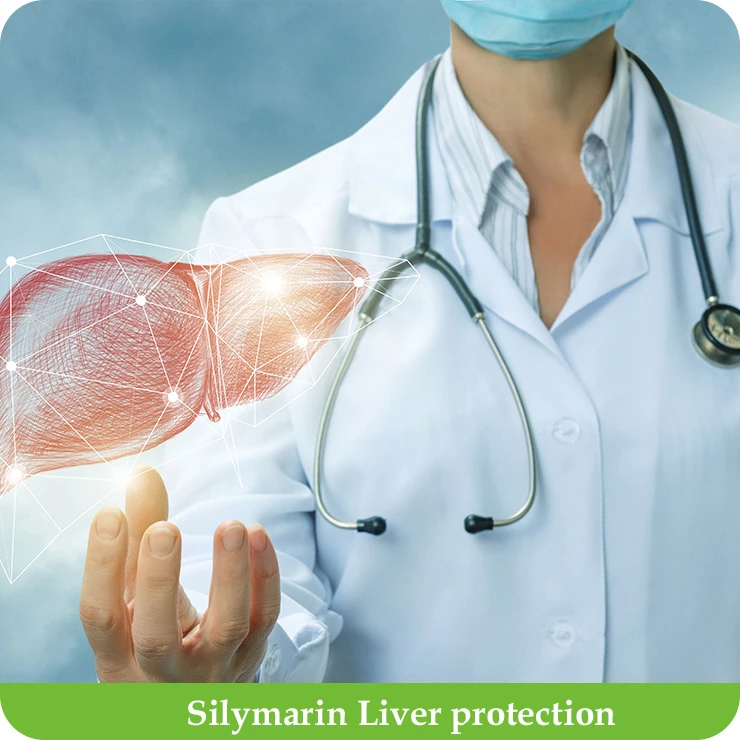Milk thistle extract An extract from the dried fruit of milk thistle, commercial extracts are usually labeled as containing 80% of the total milk thistle.
Extraction source
Milk thistle is an annual or biennial herb, native to southern Europe and North Africa and other places, in Europe and Africa has thousands of years of cultivation and use history, as a folk medicinal plant. Milk thistle is widely used to treat liver disease and cardiovascular disease. It is cultivated in North China and Northwest China.
Active ingredient
Whole grass contains flavonoids and fumaric acid; The seeds contain silybin, isosilybin, dehydrogenated silybin, silydianin, silychristin, Silybin polymer and cinnamic acid, myristate acid, palmitoleic acid, arachidonic acid, etc.
Quality of medicinal materials
Silybum marianum(Linne) Gaertner is the dried, stripped, ripened fruit of the compositaceae plant Silybum Marianum (Linne) Gaertner.
Characters: achene long oval, slightly curved, slightly flat; About 6 ~ 7mm long, up to 3mm wide, about 1.5mm thick. The upper surface has a prominent chondroid, smooth, yellow margin; a sunken umbilicus is at the bottom. The peel is soft, brownish-black or rough, grayish brown, with black or grayish-white stripes. The fatty oil and aleurone granules are present in a direct germ containing two thick, flat cotyledons.
Microscopic identification
The cuticle of the pericarp wall contains almost colorless palisade cells arranged at right angles to the surface. Tracheid with a thick outer wall and longitudinally fissure. There are grainy thickening ridges like cell walls. The subcuticle of the pericarp consists of non-lignified parenchyma cells and forms a pigment layer. Colorless cells are interlaced with a varying number of pigmented cells, giving the skin a mottled appearance. The pericarp is about 8 cells thick, and there are parenchyma cells scattered along the longitudinal axis of the fruit. The innermost cells of the peel may be crushed and contain cigar-like or monoclinic crystalline calcium oxalate crystals. The seed coat consists of a large yellow palisade cell with a narrow tubular cell, slightly expanded at the end, and the cell wall is stratified. The seed coat has special spot cells under the epidermis, and the lignified cell membrane has distinct, confined ridges or thickened (reticular cells). There is a layer of cells close to it, the cell wall is thick, slightly expanded, and has lipophilic components. The embryo consists of parenchyma cells with small glands, lumpy crystals, and fat droplets.
Thin layer identification
Test solution: Operate according to “sample solution preparation” under item 4 of [Analytical method]. Standard solution: 1.0mg/ml methanol solution of silybin standard. Developing agent: freshly prepared mixture of chloroform, acetone and anhydrous formic acid (75:16.5:8.5). Testing: The sheet was dried in cold air for 30 minutes, sprayed with 1:100 diphenylboroethoxylamine methanol solution, and left to dry; Then spray with 5% polyethylene glycol 4000; One hour later, when observed under a long-wave ultraviolet lamp, the test solution showed a strong green-blue fluorescence band with an Rf value of about 0.5(due to the presence of silybin), and a gray-blue dot with an Rf value of about 0.4, corresponding to a point in the standard solution. The test solution also showed other color bands: a strong green-blue band with an Rf value of about 0.25 (subsilymarin), and a red-orange band with an Rf value of about 0.3 (xanaxanthin).
Quality inspection
Thin-layer identification or compliance with DAB10:
Other organic matter: not more than 2.0%.
Drying weight loss: 1.0g milk thistle powder is dried at 105℃ for 2 hours, and the weight loss does not exceed 12.0%.
Total ash: 1.0g milk thistle powder measured total ash does not exceed 8.0%.
Heavy metals: not more than 0.001%; Heavy metals: Pb≤5ppm, Cd≤0.2ppm, Hg≤0.1ppm.
Pesticide residues: consistent with PHmV (1989).
Microbial limit: the total number of bacteria does not exceed 10,000 /g; The total number of molds and yeasts shall not exceed 100 /g; Salmonella, Escherichia coli, Staphylococcus aureus meet the requirements; Or comply with DAB10: Ⅷ. N7, category 4a.
Content of silymarin: This product is measured by Silibin (C25H27O10) not less than 1.0% (DAB10). Note: The United States Pharmacopeia stipulates no less than 2.0%.
Packaging and storage
Shade, moisture-proof, and airtight.
Pharmacological action
- Liver protection
Silymarin is the main active ingredient of liver protection, has a regenerative effect, can stimulate the formation of new liver cells, and improve liver function; At the same time, it can protect the liver cell membrane, prevent the infiltration of cytotoxin into the liver cells, and improve the recovery ability of membrane structure defects.
- Antioxidant
Silymarin’s phenolic hydroxyl group provides hydrogen atoms and has a powerful antioxidant effect. They have free radical scavenging properties and anti-lipid peroxidation activity.
- Reduce blood lipids
Silybin can inhibit Ca2+ channels in the plasma membrane of adult rat myocardial cells, inhibit food-induced hypercholesterolemia, reduce very low-density lipoprotein (VLDL) and low-density lipoprotein (LDL), and increase high-density lipoprotein (HDL), which can be used in the treatment of cardiovascular diseases.
Clinical efficacy
Milk thistle extract is mainly used in viral hepatitis, acute and chronic hepatitis, cirrhosis, high fatty liver, nutritional metabolic diseases, and cardiovascular diseases.
Application Overview
Milk thistle extract is widely used internationally as a preparation for the treatment of various liver diseases. Milk thistle extract is also widely used as hepatocholelitic in China








